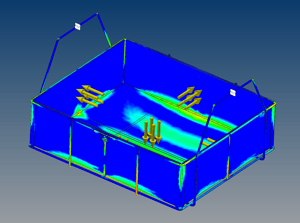 In a lot of the articles on the Marlin Steel blog, stress analysis tests are frequently mentioned as one of the key processes in the design process for any custom wire basket application. But, what are these tests, and how do they help Marlin’s degreed engineers make better wire forms for their clients?
In a lot of the articles on the Marlin Steel blog, stress analysis tests are frequently mentioned as one of the key processes in the design process for any custom wire basket application. But, what are these tests, and how do they help Marlin’s degreed engineers make better wire forms for their clients?
What is a Stress Analysis Test?
To summarize it to the point of oversimplification, a stress analysis test is a computerized simulation of the effects of various stress factors on a design to see what would happen. The specific type of test that Marlin Steel’s degreed engineers use today is called a Finite Element Analysis (FEA).
Autodesk, the maker of the FEA software Marlin uses, defines FEA as “a computerized method for predicting how a product reacts to real-world forces, vibration, heat, fluid flow, and other physical effects.” Basically, FEA breaks down a design into thousands of distinct pieces (the “finite” elements) and measures the overall impact of different types of stress on each over time.
There are several advantages to using FEA stress testing over using physical prototype testing, including:
- Faster testing speed (minutes or hours instead of weeks or months).
- Reduced expense because of the ability to test designs without having to tool for a physical prototype.
- Ability to simulate years or decades of use—increasing test thoroughness.
How Does Stress Analysis Testing Result in Better Wire Forms?
So, how does having a testing method that takes mere moments to complete and can simulate decades of use result in better wire forms? Here are a few reasons why stress analysis testing helps ensure a better overall design for custom wire forms:
- It Keeps Designers from Making Assumptions. One of the most dangerous things for any custom basket design is for the designer to make assumptions without checking those assumptions. Stress testing designs helps make sure that the design can actually take the stresses that designers might otherwise assume are fine—and spots issues that designers might fail to anticipate.
- It Ensures More Thorough Testing Than Prototype Tests. It’s a natural assumption that testing a physical prototype would be the most thorough test for a basket design, but the ability of virtual testing to simulate years of use makes it more thorough in the long run. After all, a physical prototype test can only go on for so long before it begins to delay production. The ability of FEA software to check for years of stress on a basket in minutes helps to discover issues that only appear after months of use.
- It Allows for Faster Design Iteration. Because many custom designs need to be completed on a tight schedule, the delays of physical prototyping may lead to corners being cut—a design might get one or two new iterations to address the obvious issues spotted during the physical prototype tests. Because FEA completes in minutes, it’s possible to go from one or two design iterations to dozens of design iterations in a fraction of the time. This helps to ensure that the final product’s design is as polished as possible.
Just by being relatively fast and easy to carry out, stress analysis testing helps to ensure better overall quality for custom wire forms. Being able to complete testing quickly means more design iterations can be completed, meaning there are more opportunities to polish the design and make it the best it can possibly be for a specific application.
Need a custom wire form for your manufacturing application? Contact the experts at Marlin Steel to get a custom basket quote, or for more information about Marlin’s custom wire form manufacturing process.



.gif)


